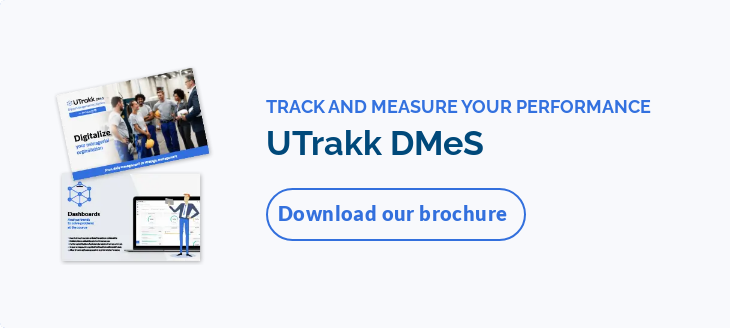Why use key performance indicators?
Key performance indicators are used to evaluate the performance of a company in different areas of the business. Collecting these metrics with comprehensive dashboards helps to paint an accurate picture of the organization's health and make informed decisions to continuously improve. You can't improve what you don't measure!

Here are 4 types of key performance indicator to measure a company's performance:
- Key performance indicators (KPIs)
- Key financial indicators (KFIs)
- Key knowledge indicators (KKIs)
- Key behavioral indicators (KBIs)
Key performance indicators (KPIs)
What is a key performance indicator?
Key performance indicators are quantifiable business metrics. These measurements enable a more efficient and accurate monitoring of operational excellence practices commonly implemented in the manufacturing world, such as ISO 9000, Lean Manufacturing, Just-in-Time, and Six Sigma.
Here are some examples of relevant key performance indicators that are used in many companies:

Sales KPIs and marketing KPIs:
- Sales revenue
- Customer acquisition cost (CAC)
- Customer lifetime value (CLV)
- Conversion rate
- Marketing return on investment (ROI)
- Lead-to-customer conversion rate
- Customer churn rate
Financial KPIs:
- Net profit margin
- Gross profit margin
- Cash flow
- Return on investment (ROI)
Customer service KPIs:
- Customer satisfaction score (CSAT)
- Net promoter score (NPS)
- Average response time
Key performance indicators should be linked to strategic goals. That’s why it’s important to define the right KPIs for your business strategy, your team and each of its members. Remember: what’s considered a good KPI for an organization might not be the same for yours. Focus on your unique business strategy and growth objectives to find the right key performance indicators.
What’s the difference between leading and lagging indicators?
Leading KPIs are proactive, forward-looking metrics that help organizations predict and shape future outcomes, while lagging KPIs are retrospective, backward-looking metrics used to assess past performance.
- Examples of leading indicators: Sales pipeline metrics, customer acquisition cost (CAC), customer churn rate, website traffic and engagement, employee turnover rate, etc.
- Examples of lagging indicators: Revenue growth, profit margin, customer retention rate, return on investment (ROI), customer satisfaction score (CSAT), etc.
Both leading indicators and lagging indicators are valuable for decision-making, but they are used in different contexts as they serve different purposes. Effective performance management often involves a balanced approach that considers both leading and lagging indicators to gain a comprehensive understanding of an organization's performance.
Key financial indicators (KFIs)
Key financial indicators are critical to measure performance of an organization’s growth. These financial metrics are used to assess the financial health of the company and see if it is creating value for its customers.

The 5 main financial performance indicators are:
- Growth: Are your sales increasing? Is your market share growing? Are you winning new customers?
- Profitability: What's your break-even point? Are you making a profit? What is your gross margin? How does your profitability rate compare with other companies in your sector?
- Liquidity: Is your working capital ratio healthy?
- Leverage: Are you taking advantage of financing to grow your business?
- Activity: Are your company's assets well managed?
To increase its financial health, an organization can implement improvement initiatives targeting these financial performance indicators. Here, a financial expert can guide you in the use of appropriate strategies:
- Investment
- Restructuring
- Market capture
- Technology integration
- Acquisition
What are the limits of financial indicators?
Essential to the survival of a company, KFIs are the main decision-making metrics in the early stages of its evolution. However, such key performance indicators offer a strictly financial view of the organization and its performance, which hampers the possibility of improving operational performance.
Although key financial indicators can now be analyzed in real-time with new technologies (as opposed to a traditional annual or monthly analysis), they only provide visibility on the company's results. The assessment of operational processes that provides the necessary insight for organizations to act on the financial objectives and their results is overlooked.
Key knowledge indicators (KKIs)
Key knowledge indicators measure knowledge and worker engagement to assess available human resources performance.
Specifically, these key performance indicators focus on the workforce, that is the people that apply the operational and business processes on a daily basis. They help determine if the employees have the technical knowledge to sustain the organization, if they effectively make use of this knowledge, and if they have the willingness to develop it.

Areas of knowledge that can be measured include:
- Technical knowledge
- Procedural knowledge
- Organizational knowledge
Each individual in a company contributes knowledge through their mastery and their willingness to harness it for the benefit of the organization.
Jean-Philippe Raîche, Associate, Proaction International
If each employee possesses the required level of theoretical and practical knowledge for their job, those who manage them must also know their role in driving the operational and financial performance of the organization.
Key behavioral indicators (KBIs)
How do KBIs help improve business performance?
The strength of the company lies in the managers' ability to learn good practices and implement them on a daily basis, and to encourage their teams to continuously leverage those practices. This requires tremendous operational discipline and the skills to engage employees.
That’s where key behavioral indicators come in. KBIs are used to measure performance of management behaviors that support organizational operations.
By measuring the managerial performance of all supervisors (team leaders, foremen, directors, etc.), it is easier to pinpoint areas of improvement and act on developing their skills and behaviors through training and leadership coaching.

Key performance indicators of behaviors measure managerial performance from 4 angles:
- Knowledge: Management Skills Index (MSI)
- Know-how: Active Supervision Index (ASI), Management Effectiveness Index (MEI)
- Management style: Objective Orientation (O2), Consideration Factors Index (CF2)
- Mindset: Organizational Mobilization Index (OMI), Personal State Index (PSI)
Set the right key performance indicators for your organizational maturity
The more mature an organization, the more precise and comprehensive its key performance indicators will be. That’s why it is impossible to use a one-size-fits-all approach – key performance indicators must be defined to provide relevant insights on where an organization stands and where it wants to go, and that depends on each company’s maturity.
The stronger and more experienced the company is, the more it can look further and deeper into measuring its organizational performance to make a meaningful impact.
So, where should you start? Organizations often start by establishing key performance indicators related to their finances (KFIs) before setting up KPIs to optimize their operations.
When you are ready to go deeper into measuring organizational performance, you can assess the knowledge performance of your workforce (KKIs) and work with a leadership coach to set up key behavioral indicators (KBIs). Most importantly, track and monitor each key performance indicator over time and implement changes to keep improving. And you’ll have a massive and lasting impact on overall business performance.









